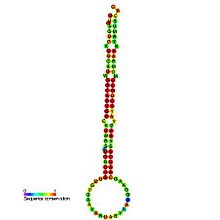- mir-34 microRNA precursor family
-
mir-34 microRNA precursor family 
Predicted secondary structure and sequence conservation of mir-34 Identifiers Symbol mir-34 Rfam RF00456 miRBase MI0000268 miRBase family MIPF0000039 Other data RNA type Gene; miRNA Domain(s) Eukaryota GO 0035195 0035068 SO 0001244 The human mir-34a microRNA was discovered computationally[1] and later verified experimentally.[2] The mature sequence is excised from the 5' arm of the hairpin. This microRNA has recently been implicated in cancer particularly with its expression relating to TP53 status.[3] The expression of this miRNA has also been confirmed in embryonic stem cells.[4]
Contents
Targets of miR-34
- Yamakuchi et al.. showed that miR-34a targets the silent information regulator 1 SIRT1 gene.[5]
miR-34 inhibition of SIRT1 leads to an increase in acetylated p53 and expression of p21 and PUMA, transcriptional targets of p53 that regulate the cell cycle and apoptosis, respectively. Furthermore, miR-34 suppression of SIRT1 ultimately leads to apoptosis in WT human colon cancer cells but not in human colon cancer cells lacking p53. Finally, miR-34a itself is a transcriptional target of p53, suggesting a positive feedback loop between p53 and miR-34a. Thus, miR-34a functions as a tumor suppressor, in part, through a SIRT1-p53 pathway.
Mir-34 inhibits human p53-mutant gastric cancer tumorspheres
p53-deficient human gastric cancer cells, restoration of functional miR-34 inhibits cell growth and induces chemosensitization and apoptosis, indicating that miR-34 may restore p53 function. Restoration of miR-34 inhibits tumorsphere formation and growth, which is reported to be correlated to the self-renewal of cancer stem cells. The mechanism of miR-34-mediated suppression of self-renewal appears to be related to the direct modulation of downstream targets Bcl-2, Notch, and HMGA2, indicating that miR-34 may be involved in gastric cancer stem cell self-renewal/differentiation decision-making. [6][7]
References
- ^ Lim, LP; Glasner ME, Yekta S, Burge CB, Bartel DP (2003). "Vertebrate microRNA genes". Science 299 (5612): 1540–. doi:10.1126/science.1080372. PMID 12624257.
- ^ Dostie, J; Mourelatos Z, Yang M, Sharma A, Dreyfuss G (2003). "Numerous microRNPs in neuronal cells containing novel microRNAs". RNA 9 (2): 180–186. doi:10.1261/rna.2141503. PMC 1370383. PMID 12554860. http://www.pubmedcentral.nih.gov/articlerender.fcgi?tool=pmcentrez&artid=1370383.
- ^ He L, He X, Lim LP, et al (June 2007). "A microRNA component of the p53 tumour suppressor network". Nature 447 (7148): 1130–4. doi:10.1038/nature05939. PMID 17554337.
- ^ Houbaviy HB, Murray MF, Sharp PA (2003). "Embryonic stem cell-specific MicroRNAs.". Dev Cell 5 (2): 351–8. doi:10.1016/S1534-5807(03)00227-2. PMID 12919684.
- ^ Yamakuchi M, Ferlito M, Lowenstein CJ (September 2008). "miR-34a repression of SIRT1 regulates apoptosis". Proceedings of the National Academy of Sciences of the United States of America 105 (36): 13421–6. doi:10.1073/pnas.0801613105. PMC 2533205. PMID 18755897. http://www.pubmedcentral.nih.gov/articlerender.fcgi?tool=pmcentrez&artid=2533205.
- ^ Ji Q, Hao X, Meng Y, Zhang M, Desano J and Fan D et al. Restoration of tumor suppressor miR-34 inhibits human p53-mutant gastric cancer tumorspheres. BMC Cancer 2008; 8: 266.
- ^ Mir-34 and p53 pathway
External links
miRNA precursor families 1-100 101-200 201+ Other Categories:- MicroRNA
- Molecular and cellular biology stubs
Wikimedia Foundation. 2010.
